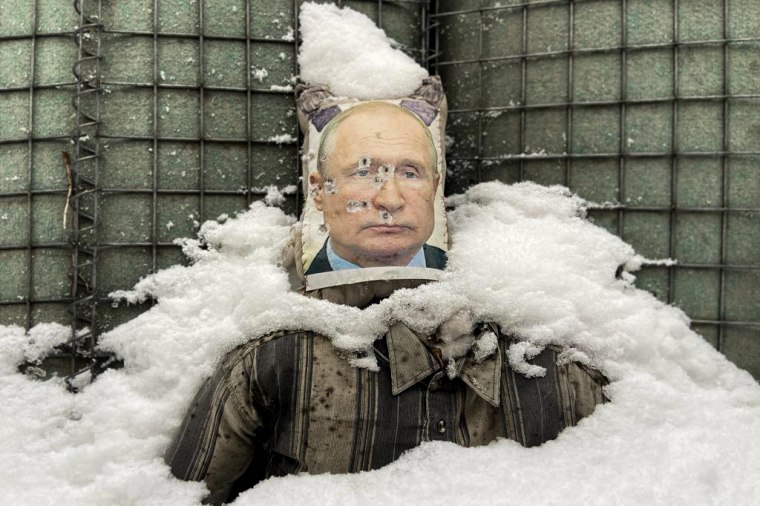Russia has already assembled 70 percent of the forces it would need to launch a full-scale invasion of Ukraine, a U.S. official with direct knowledge of the latest government assessment said late Friday amid spiraling tensions in the region.
An invasion would be likely to cause significant casualties, killing or wounding up to 50,000 civilians within weeks, according to the official, who discussed the internal assessment on condition of anonymity.
Were President Vladimir Putin to decide on that course of action, the Ukrainian capital, Kyiv, would most likely be captured in the early days of the invasion, possibly within the first 48 hours, the official said, describing the assessment.

It was unclear how the government arrived at the estimates; NBC News has not seen supporting documents.
Defense Department officials were not immediately available for comment about the report. Russian officials did not respond to requests for comment.
Up to 5 million people could become refugees were an invasion to happen, and 5,000 to 25,000 Ukrainian troops would most likely be killed or wounded, the assessment concluded, according to the source.
Moscow denies it is planning to attack Ukraine, a former Soviet republic. In a series of bold security demands, the Kremlin has called on NATO to deny membership to Ukraine and other ex-Soviet countries. It has also called on the military alliance to roll back its military deployments in Central and Eastern Europe, claiming NATO expansion poses a serious threat to Russia.
The U.S. assessment showed that 83 battalion tactical groups made of up to 1,000 troops, each armed with artillery and mortars, are surrounding Ukraine, up from 60 two weeks ago, the source said. An additional 14 are on their way to join them from other parts of the country, the source said, citing the assessment.
The assessment concluded that around 120 would be optimal to launch a full-scale invasion, the official said. Fighter jets, missile systems, helicopters, ships and submarines are also in place, the official added.
The rate at which troops and equipment are arriving at the border means Russia may be at full capacity to invade by Feb. 15, when the ground at the border is expected to be optimally frozen for tracked vehicle movement through to the end of March, the source said, citing the assessment.
The source added that the assessment also repeated warnings that Russia planned “false flags operations” to justify conflict, including waging disinformation campaigns, sabotaging infrastructure or sparking protests or unrest.
Moscow has also moved strategic exercises using air-, sea- and land-based weapons able to launch nuclear weapons from the fall to later this month, the U.S. official said, describing the assessment.
Officials expect Russia to test missiles with various ranges, including intercontinental ballistic missiles without nuclear warheads, the source said.
Putin has not made a final decision about an invasion and may not have ruled out the possibility of more limited options, although a diplomatic solution appears to remain possible, the source said.
While the intelligence indicates that Russia continues to ready for a possible invasion, one is not inevitable, said Keir Giles, a senior consulting fellow at the London based think tank Chatham House.
“Russia is continuing the long drawn out process of steadily amassing the necessary capabilities for a full-scale new assault on Ukraine,” he said by email.
"That doesn’t make a new invasion inevitable — President Putin has described this as a means of putting pressure on the West that needs to be strung out as long as possible.
“But there are fewer and fewer doubts that Russia could mount a major escalation if it wished to, and Ukraine and its Western partners have no option but to prepare accordingly,” he added.
Putin said Tuesday that the U.S. and NATO had ignored Russia's demands and accused them of using Ukraine as “a tool” in its efforts to contain Russia and lure it into war.
Dmitry Polyanskiy, Russia’s deputy ambassador to the United Nations, dismissed the reports.
“Madness and scaremongering continues,” he wrote on Twitter. “What if we would say that US could seize London in a week and cause 300K civilian deaths? All this based on our intelligence sources that we won’t disclose.”
Putin met with Chinese President Xi Jinping at the Beijing Winter Olympics on Friday and received strong support from his counterpart.
“In 2014, Russia seized and annexed Crimea and started its war in eastern Ukraine without consulting China. This time is very different. Intense diplomacy between the two countries has left Russia as confident as possible that its next move will not incur Chinese disapproval,” Giles said.
Russia and Belarus, a close ally of Russia's on Ukraine's northern border, have said they will hold joint exercises Feb. 10-20.
NATO Secretary-General Jens Stoltenberg said last week that the Russian maneuvers in Belarus were the biggest Russian deployment in the area since the Cold War, adding that nuclear-capable Iskander missiles were a part of it.
Russia said Saturday that it had sent a pair of long-range nuclear-capable bombers on patrol over Belarus. The Tu-22M3 bombers practiced interacting with the Belarusian air force and air defense in a four-hour mission, the Russian Defense Ministry said.
Courtney Kube reported from Washington and Rhoda Kwan from Melbourne, Australia.
